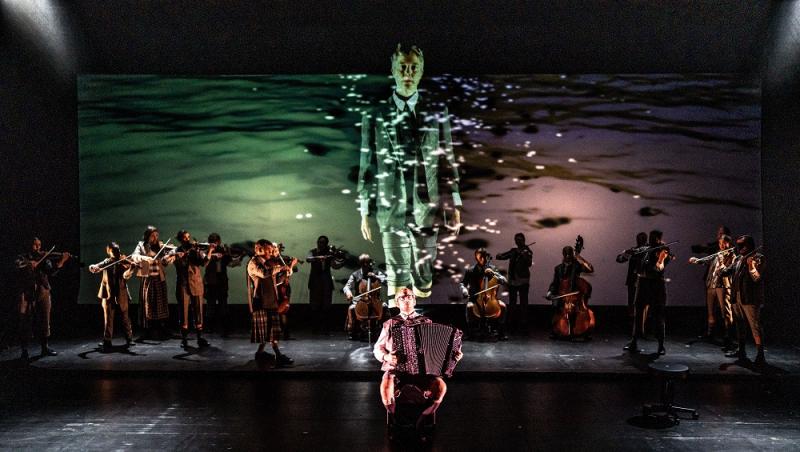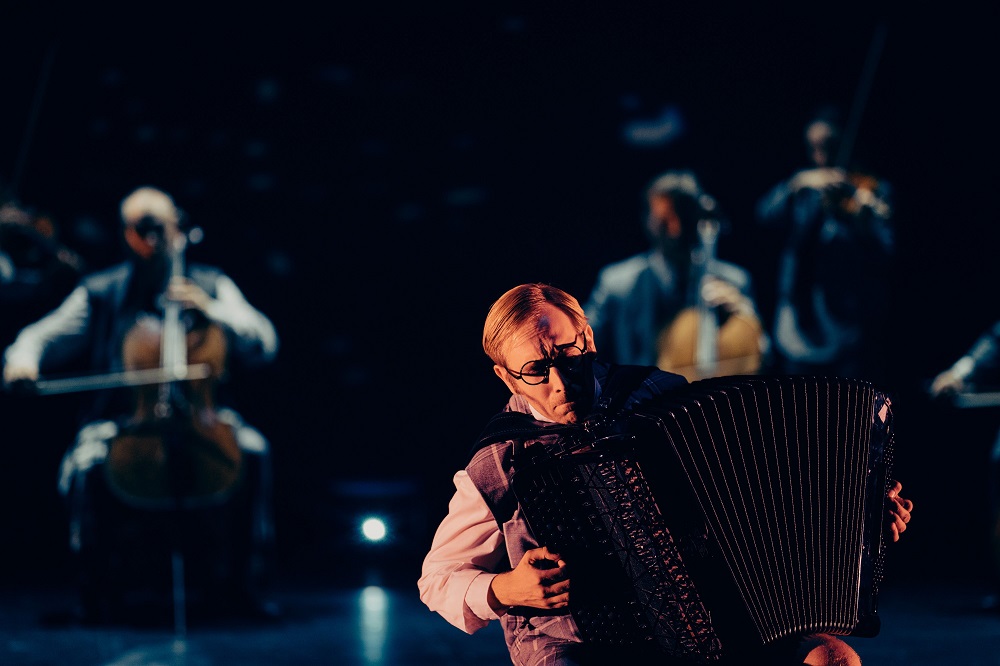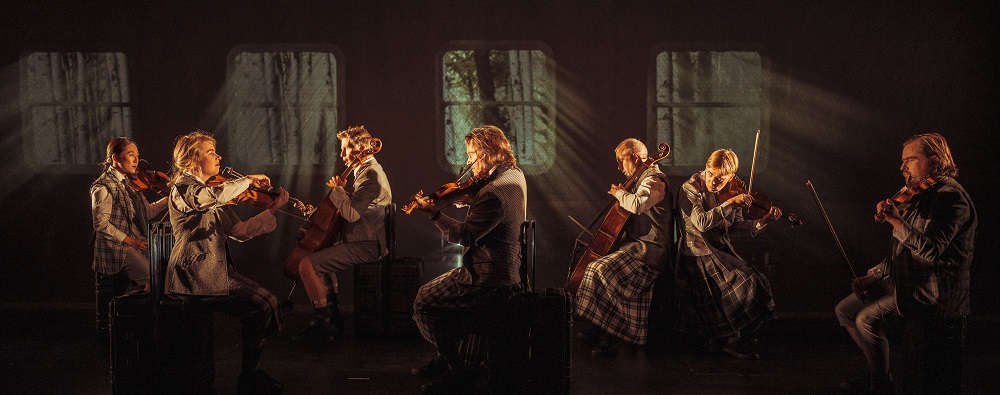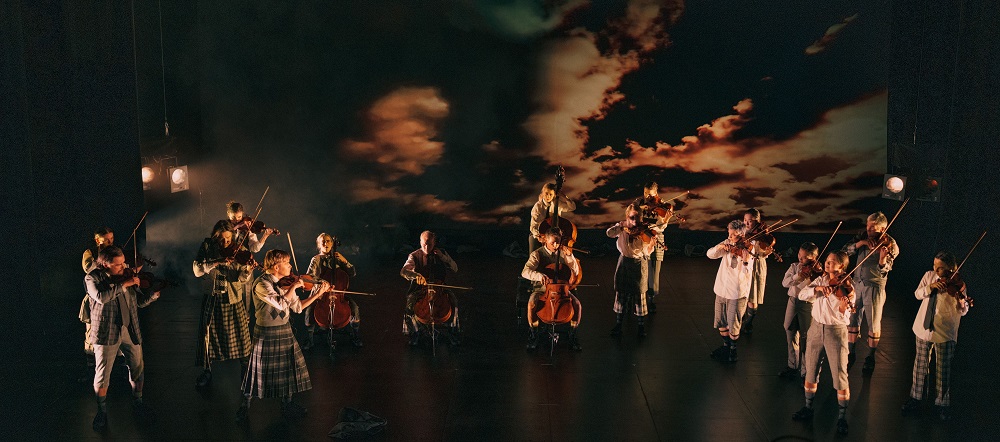Concert Theatre DSCH, Norwegian CO, Oslo Opera House Scene 2 review - Shostakovich choreographed for strings and accordion | reviews, news & interviews
Concert Theatre DSCH, Norwegian CO, Oslo Opera House Scene 2 review - Shostakovich choreographed for strings and accordion
Concert Theatre DSCH, Norwegian CO, Oslo Opera House Scene 2 review - Shostakovich choreographed for strings and accordion
90 minutes of by-heart playing with movement from some of the world's best players

Do we really need instrumental Shostakovich with lighting, movement, costumes and video projection? I might have said no before having seen what the Norwegian Chamber Orchestra could do with former leader Terje Tønnesen, performing the Chamber Symphony by heart in dramatic style. It seemed likely that memorizing even more music under new Artistic Director Pekka Kuusisto, and performing it in an insanely demanding dramatic framework, with no word spoken, could work.
It does, beyond anyone's wildest imaginings. This collaboration is with a visionary Danish team: director Mikkel Harder Munck-Hansen, who chose most of the music from an encyclopedic knowledge of Shostakovich and knows how to alternate light, light-serious and profound; lighting, scenography and video design by Lars Egegaard Sørensen rising from near-darkness; and beautifully tailored, androgynous costuming by Maja Ravn, which shouldn't work but does. Within this the music-making, whatever the players are asked to do, remains paramount. We start with an eerily rotating moon, the desolation of the composer's swansong Viola Sonata played by Ida Klokk-Bryhn, who's soon joined by eerie accordion sounds from Bjarke Mogensen (another Dane, and one of the world's great players – pictured above – whom I first heard him in a stunning transcription of Stravinsky's complete Petrushka with fellow-accordionist Rasmus Schjærff Kjøller).
Within this the music-making, whatever the players are asked to do, remains paramount. We start with an eerily rotating moon, the desolation of the composer's swansong Viola Sonata played by Ida Klokk-Bryhn, who's soon joined by eerie accordion sounds from Bjarke Mogensen (another Dane, and one of the world's great players – pictured above – whom I first heard him in a stunning transcription of Stravinsky's complete Petrushka with fellow-accordionist Rasmus Schjærff Kjøller).
If there is any biographical hint in the evening, it's in the round glasses which suggest Mogensen as the often lonely composer. But thankfully nothing is tied down to the anecdotal, and there's not an image of Stalin or even of Soviet Russia to be found. Contrast is of the essence. Two violinists back to back suggest eccentric revue; double-bass player Katrine Sonstad as a red-clad angel dominates the ensemble as she takes the cello's part (pictured below), while cellist Øystein Sonstad takes centre stage in the most flamboyant tour de force of the evening, the other players stamping and instrumentally shouting around him in the opening movement of the First Cello Concerto. Kuusisto's preliminary burlesque as a grotesque wielding a bass drum plays off with his well-timed strokes during the movement; otherwise, at least until the Chamber Symphony, he's totally part of the team.  Sonstad is also an arranger of genius; only the lower string soloists are allowed to play the familiar tune of the Waltz from the Second Jazz Suite against a lyrical natural background. The decision to take the limpid neoromantic Andante of the Second Piano Concerto and entrust it to Mogensen's extreme sensitivity is one of many moving surprises.
Sonstad is also an arranger of genius; only the lower string soloists are allowed to play the familiar tune of the Waltz from the Second Jazz Suite against a lyrical natural background. The decision to take the limpid neoromantic Andante of the Second Piano Concerto and entrust it to Mogensen's extreme sensitivity is one of many moving surprises.
The co-ordination required between playing and precise music-theatre defies belief. The nervy opening movement of the Seventh String Quartet is not only shared between two groups, sometimes joining, but in Munck-Hansen's imaginative choreography against a forest viewed through train windows requires the players to change their seats on suitcases with eye-popping regularity (pictured below).  The players are occasionally required to observe a stony impassiveness against the grain of the emotional music they're playing, as in the opening of the Eighth Symphony, but this too works, especially when Grønsdal evokes a narrative of figures emerging to reach giant form before vanishing or collapsing. Sometimes the musical demands are so great that a freer wildness is allowed, as in a stupendous inferno of a second movement from the Two Pieces for String Octet. Sure-footed contrast allows Mogensen to follow this with a necessary sweet resting place in the Romance from the Dances of the Dolls, the one piece I didn't recognise; it sounded like a perfect, briefly Bachian preludes.
The players are occasionally required to observe a stony impassiveness against the grain of the emotional music they're playing, as in the opening of the Eighth Symphony, but this too works, especially when Grønsdal evokes a narrative of figures emerging to reach giant form before vanishing or collapsing. Sometimes the musical demands are so great that a freer wildness is allowed, as in a stupendous inferno of a second movement from the Two Pieces for String Octet. Sure-footed contrast allows Mogensen to follow this with a necessary sweet resting place in the Romance from the Dances of the Dolls, the one piece I didn't recognise; it sounded like a perfect, briefly Bachian preludes.
While this is being played, the other participants move onstage and discreetly tune up – it's also part of the action – for a complete performance of the Chamber Symphony (Rudolf Barshai's arrangement of the Eighth String Quartet; pictured below). Kuusisto is very much the leader here, as was Tønnesen, but the dynamic is quite different, less a drama of the individual persecuted by the masses, more a stonier start which makes the following movements all the more striking in their dramatically expressed ferocity. Sonstad manages the poignant reminiscence from Lady Macbeth of Mtsensk, the only ray of tentative light in the entire work, more ethereally than I've heard it even from a string-quartet cellist (he is a member, incidentally, of the Oslo Quartet).  Then Kuusisto goes eerily off-string to signal the final ritual. It's all ineffably well paced, logical, inevitable, and it unfolds against perfect skyscapes: black clouds rushing forward, going in to sulphurous retreat, flaming red, settling to sunset and then a couple of stars in the darkening sky. The moon and the viola return for an equally perfect epilogue. The sound, incidentally, involves mikes on each of the players, but not for amplification, just to catch them when they move. I wouldn't have known, so homogenous is the tone in ensembles, so naturally beautiful. I've never experienced anything quite like this; it has to come to London.
Then Kuusisto goes eerily off-string to signal the final ritual. It's all ineffably well paced, logical, inevitable, and it unfolds against perfect skyscapes: black clouds rushing forward, going in to sulphurous retreat, flaming red, settling to sunset and then a couple of stars in the darkening sky. The moon and the viola return for an equally perfect epilogue. The sound, incidentally, involves mikes on each of the players, but not for amplification, just to catch them when they move. I wouldn't have known, so homogenous is the tone in ensembles, so naturally beautiful. I've never experienced anything quite like this; it has to come to London.
- Concert Theatre DSCH runs until 8 June at Scene 2 of Oslo Opera House
- There will be a Q&A on theartsdesk with Pekka Kuusisto shortly before his Prom with the Deutsche Kammerphilhamonie on 16 July
- More classical reviews on theartsdesk
rating
Explore topics
Share this article
The future of Arts Journalism
You can stop theartsdesk.com closing!
We urgently need financing to survive. Our fundraising drive has thus far raised £49,000 but we need to reach £100,000 or we will be forced to close. Please contribute here: https://gofund.me/c3f6033d
And if you can forward this information to anyone who might assist, we’d be grateful.

Subscribe to theartsdesk.com
Thank you for continuing to read our work on theartsdesk.com. For unlimited access to every article in its entirety, including our archive of more than 15,000 pieces, we're asking for £5 per month or £40 per year. We feel it's a very good deal, and hope you do too.
To take a subscription now simply click here.
And if you're looking for that extra gift for a friend or family member, why not treat them to a theartsdesk.com gift subscription?
more Classical music
 Robin Holloway: Music's Odyssey review - lessons in composition
Broad and idiosyncratic survey of classical music is insightful but slightly indigestible
Robin Holloway: Music's Odyssey review - lessons in composition
Broad and idiosyncratic survey of classical music is insightful but slightly indigestible
 Classical CDs: Wolf-pelts, clowns and social realism
British ballet scores, 19th century cello works and contemporary piano etudes
Classical CDs: Wolf-pelts, clowns and social realism
British ballet scores, 19th century cello works and contemporary piano etudes
 Bizet in 150th anniversary year: rich and rare French offerings from Palazzetto Bru Zane
Specialists in French romantic music unveil a treasure trove both live and on disc
Bizet in 150th anniversary year: rich and rare French offerings from Palazzetto Bru Zane
Specialists in French romantic music unveil a treasure trove both live and on disc
 Scottish Chamber Orchestra, Ibragimova, Queen’s Hall, Edinburgh review - rarities, novelties and drumrolls
A pity the SCO didn't pick a better showcase for a shining guest artist
Scottish Chamber Orchestra, Ibragimova, Queen’s Hall, Edinburgh review - rarities, novelties and drumrolls
A pity the SCO didn't pick a better showcase for a shining guest artist
 Kilsby, Parkes, Sinfonia of London, Wilson, Barbican review - string things zing and sing in expert hands
British masterpieces for strings plus other-worldly tenor and horn - and a muscular rarity
Kilsby, Parkes, Sinfonia of London, Wilson, Barbican review - string things zing and sing in expert hands
British masterpieces for strings plus other-worldly tenor and horn - and a muscular rarity
 From Historical to Hip-Hop, Classically Black Music Festival, Kings Place review - a cluster of impressive stars for the future
From quasi-Mozartian elegance to the gritty humour of a kitchen inspection
From Historical to Hip-Hop, Classically Black Music Festival, Kings Place review - a cluster of impressive stars for the future
From quasi-Mozartian elegance to the gritty humour of a kitchen inspection
 Shibe, LSO, Adès, Barbican review - gaudy and glorious new music alongside serene Sibelius
Adès’s passion makes persuasive case for the music he loves, both new and old
Shibe, LSO, Adès, Barbican review - gaudy and glorious new music alongside serene Sibelius
Adès’s passion makes persuasive case for the music he loves, both new and old
 Anja Mittermüller, Richard Fu, Wigmore Hall review - a glorious hall debut
The Austrian mezzo shines - at the age of 22
Anja Mittermüller, Richard Fu, Wigmore Hall review - a glorious hall debut
The Austrian mezzo shines - at the age of 22
 First Person: clarinettist Oliver Pashley on the new horizons of The Hermes Experiment's latest album
Compositions by members of this unusual quartet feature for the first time
First Person: clarinettist Oliver Pashley on the new horizons of The Hermes Experiment's latest album
Compositions by members of this unusual quartet feature for the first time
 Gesualdo Passione, Les Arts Florissants, Amala Dior Company, Barbican review - inspired collaboration excavates the music's humanity
At times it was like watching an anarchic religious procession
Gesualdo Passione, Les Arts Florissants, Amala Dior Company, Barbican review - inspired collaboration excavates the music's humanity
At times it was like watching an anarchic religious procession
 Classical CDs: Camels, concrete and cabaret
An influential American composer's 90th birthday box, plus British piano concertos and a father-and-son duo
Classical CDs: Camels, concrete and cabaret
An influential American composer's 90th birthday box, plus British piano concertos and a father-and-son duo
 Cockerham, Manchester Camerata, Sheen, Martin Harris Centre, Manchester review - re-enacting the dawn of modernism
Two UK premieres added to three miniatures from a seminal event of January 1914
Cockerham, Manchester Camerata, Sheen, Martin Harris Centre, Manchester review - re-enacting the dawn of modernism
Two UK premieres added to three miniatures from a seminal event of January 1914

Add comment